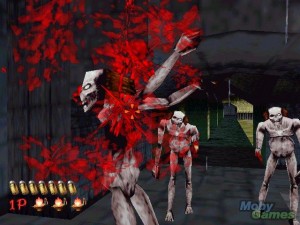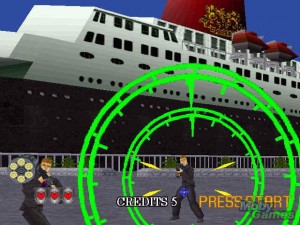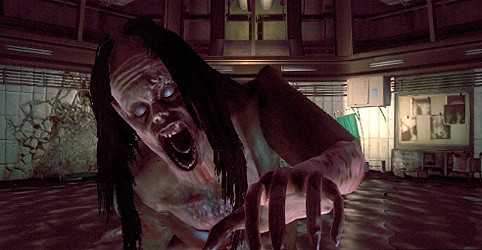 After an extended hiatus, Christopher Bell is back with our gaming retrospective column, proving that rumours of his demise have been greatly exaggerated. The same can’t be said for the residents of the Curien Mansion, however. It’s time to take a look around The House of the Dead…
After an extended hiatus, Christopher Bell is back with our gaming retrospective column, proving that rumours of his demise have been greatly exaggerated. The same can’t be said for the residents of the Curien Mansion, however. It’s time to take a look around The House of the Dead…
On the night of December 18th 1998, Agent Thomas Rogan receives a frenzied telephone call from his fiancée Sophie, a researcher working for the infamous geneticist Dr. Curien. She’s at Curien’s mansion but the call ominously cuts off before she can fully explain her situation. Rogan hurries to the scene with his partner – a mysterious man by the name of ‘G’ – to find and rescue her. The agents have no choice but to explore the mansion and face with the horrors within…
SEGA had a great run of arcade light-gun shooters way back in the early-to-mid 90s. It started with Virtua Cop, which revolutionised the classic sideways scrolling shooter by putting players in an immersive 3D environment. The House of the Dead continued the trend – amid new competition from the likes of Namco’s Time Crisis – whilst throwing in a few unique twists of its own.
Most immediately noticeable was the fact that one shot did not immediately kill your enemy here (unless you got them in the head). Instead, shooting a limb or other body part destroyed it in a shower of gore. This was deemed too graphic for some markets (including the UK) where the colour of the blood was changed to green.
(Surprisingly, the biggest controversy surrounding the game was not triggered by the gore but by the light-guns themselves, which were painted black and looked surprisingly realistic. You can still find some attached to original machines today).
And for the first time, your accuracy affected your route through the level. In the opening level, for example, you find a researcher about to be thrown off a bridge by a zombie. Saving him means you will enter the mansion through the front door. If he dies, you are forced to enter through the sewers – a far more dangerous route.
The arcade release did extremely well. As the last game to be made using the Model 2 arcade board (the same board used for Virtua Cop 2 and Virtua Fighter 2), a home version was soon confirmed, and released for SEGA’s Saturn console in 1998. It was to be one of the Saturn’s last games.
In the same year, SEGA announced the inevitable sequel. House of the Dead 2 used the Dreamcast-based Naomi board, and broke free from the confines of the Curien Mansion to wreak havoc in the streets of Venice.
Two further numbered sequels followed. Part 3 (2001) was originally intended for release on SEGA’s ill-fated Dreamcast console and had to be reworked for release on the Xbox and Wii, as so many people hated the comic book cel-shaded graphics (a look that was in vogue back in the day). Part 4 followed in 2006, but stayed in arcades until 2011, when it finally came out on PSN with Move support.
In 2009, SEGA tried something radical. The House of the Dead had never been a franchise synonymous with snappy dialogue and great acting – a fact compounded by Uwe Boll’s execrable movie adaption – but instead of hiring better actors, SEGA went the other way. House of the Dead: Overkill was set in 1970s’ Louisiana, and was pitched as a tongue-in-cheek Grindhouse B-movie. Even more surprisingly, it was released on the Wii (eventually coming to the PS3 two years later) and set the record for the highest number of f-words in a game: 200 f-bombs in total!
Game: The House of the Dead
Developer/Publisher: Wow Entertainment (then AM1)/SEGA
Platforms: Arcade, Saturn, PC
Year: 1997



